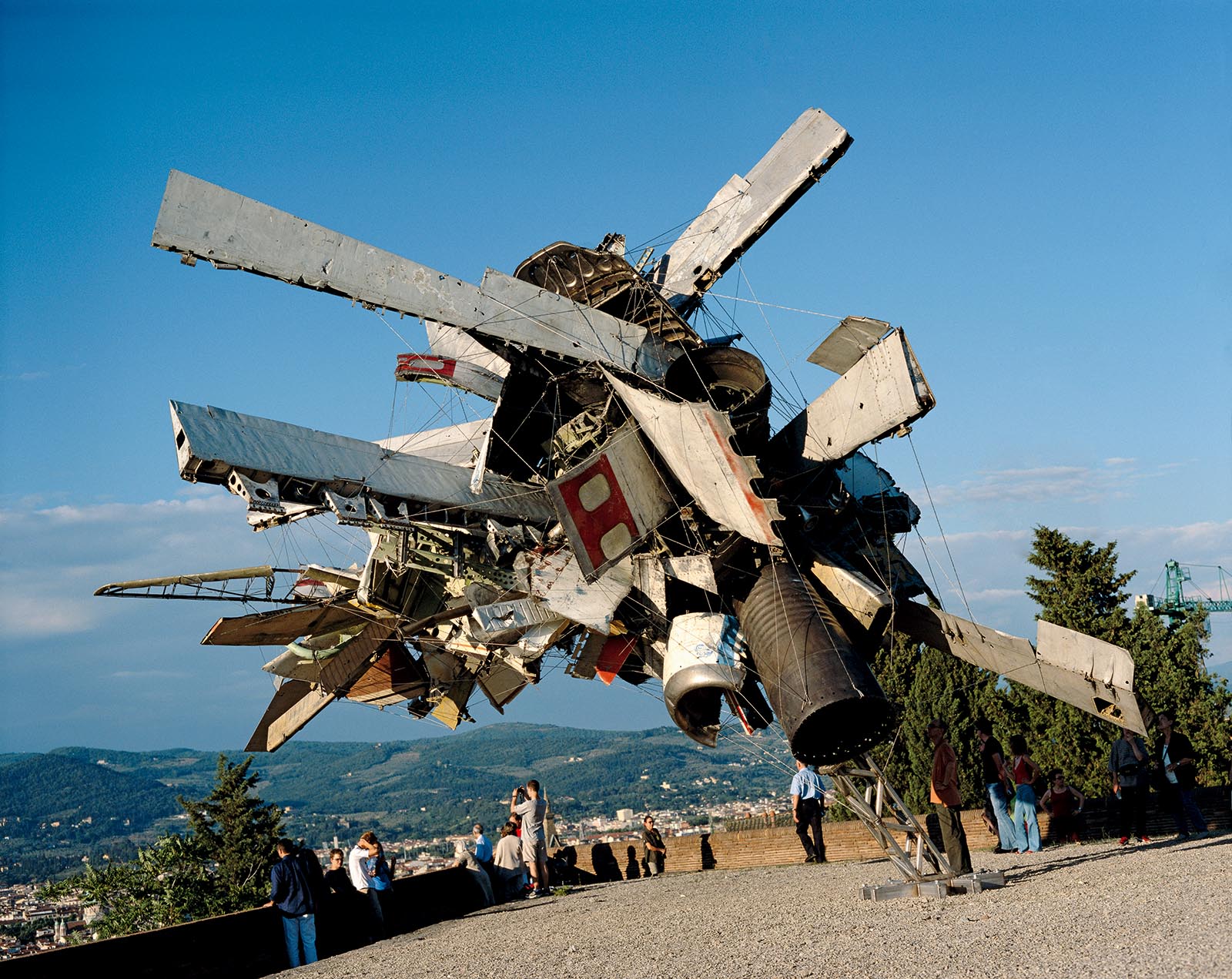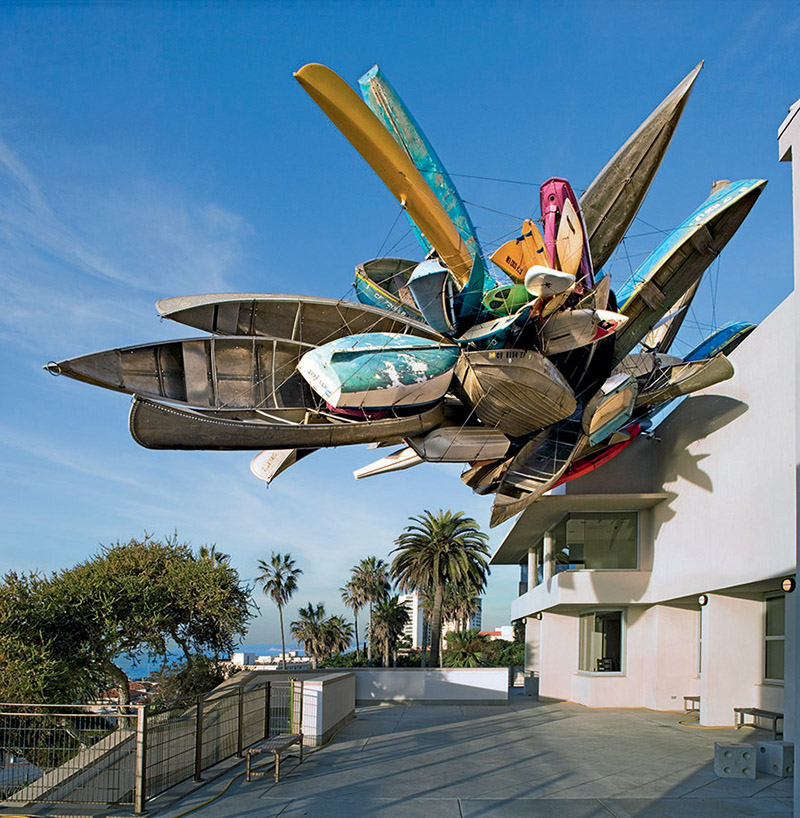
MoMA & Airplane Parts at Forte Belvedere, Florence, Italy, 2003. Airplane parts, steel, black tie-wire cable, 27 x 42 x 25 ft. Forte Belvedere, Florence, Italy. Image courtesy of the artist.

Mattresses and Cakes, 1993. Mattresses, cakes, rebar, black tie-wire cable, approx 23 x 18 x 18 ft. Installation at the Arsenale, Venice, Italy. Image courtesy of the artist.

Pleasure Point, 2006. Boats, stainless steel, stainless steel wire cable, 25 x 53 x 24 ft. Museum of Contemporary Art San Diego La Jolla, La Jolla, CA. Image courtesy of the artist.
BIOGRAPHY
Nancy Rubins creates dynamic sculptures and drawings that investigate the liminality between two-dimensionality and three-dimensionality, and the intersection of engineering and art. In 1974, she completed a BFA at the Maryland Institute College of Art in Baltimore and then moved to the West Coast to study at the University of California at Davis, where she earned an MFA two years later. During this period, she began collecting used appliances—hair dryers, electric shavers, toaster ovens, televisions—which she included in large, semiflexible wall-like sculptures. Initially sourcing her materials from garbage dumps and thrift stores, Rubins mined not only the vast quantities of inexpensive objects she amassed, but also the history of each salvaged item.
From the early-1980s, Rubins’ assemblages took the forms of tornado or massive wave shapes. Her practice evolved in the 1990s to include immense clusters of sizeable objects such as boats, mattresses, or the deconstructed parts of manufactured machinery like airplanes and trailers. In the 2000s, Rubins began producing rhizomatic large-format assemblages composed of weathered cast-aluminum playground animals bound together with cables. This technique evolved to include the use of other materials, such as cast-iron, brass, and bronze animal sculptures.
The act of mark-making is integral to Rubins’ abstract drawing practice using graphite on paper. In the mid-1970s, the artist began producing increasingly concentrated compositions, covering the entire surface of the paper with graphite to create shiny metallic surfaces that have endless depth of space as well as textured traces of the artist’s hand. These drawings often comprise multiple large sheets of paper that are layered and affixed to a wall, with three-dimensional furrows that exploit the sculptural potential of the medium.
Rubins’ work has been shown internationally and her large-scale, outdoor sculptures are on permanent display at institutions throughout the world, including the Albright-Knox Art Gallery, Buffalo, NY and Université Paris Diderot, Paris. She has had numerous solo exhibitions, most recently at Gagosian Beverly Hills earlier this year, as well as group exhibitions. An exhibition of work from her series Our Friend Fluid Metal opens September 30 at the Art Institute of Chicago.
Her work is in prominent public collections including: Albright-Knox Art Gallery, Buffalo, NY; Austrian Sculpture Park, Graz, Austria; City of Paris, France; Eli Broad Foundation, Los Angeles, CA; Hammer Museum, Los Angeles, CA; Knoxville Museum of Art, Knoxville, TN; Museum of Contemporary Art, Chicago, IL; Museum of Contemporary Art, Los Angeles, CA; Museum of Modern Art, New York, NY; and University of Texas at Austin, among others. In 1993, Rubins was invited to participate in the Venice Biennale and was included in the Whitney Biennial in the same year.
Among her many awards are the 2013 Distinguished Women in Arts, Museum of Contemporary Art, Los Angeles, CA and the 2003 Academy Award in Art from the American Academy of Arts and Letters.
Rubins taught sculpture at the University of California, Los Angeles from 1982 to 2004 and resides and works in Topanga, California. Her Instagram is @nancyrubinsstudio.
PRESS RELEASE
NANCY RUBINS RECEIVES ARTISTS’ LEGACY FOUNDATION 2021 ARTIST AWARD
OAKLAND, CALIFORNIA—The Artists’ Legacy Foundation today announced that Nancy Rubins (b. 1952)—celebrated for her innovative sculptural practice—is the recipient of its 2021 Artist Award. The unrestricted merit award of $25,000 is given to a visual artist whose primary medium is painting or sculpture in recognition of their professional achievements. Each year, ten artists are proposed for the Award by five anonymous nominators. Like the nominators, the jury of three comprises art-world peers who make the final decision.
Squeak Carnwath, the Foundation’s board president, said, “Nancy Rubins is one amazing artist. Her work is exuberant, dynamic, and gravity defying. The sculptures occupy a place of twin feelings of excitement and fear. They look like a feral King Kong put them together in a tornado. The work is ambitious and confident. Rubins is a courageous risk-taker and is as fierce as her sculptures are bold. The jurors did a marvelous job, and we sincerely appreciate their service, acumen, and enthusiasm.”
This year’s jurors were: Mary Ceruti, Executive Director of the Walker Art Center in Minneapolis, MN; Julia Couzens, artist and writer; and Craig Nagasawa, artist and Senior Continuing Lecturer for Painting and Drawing, University of California, Berkeley. They described Rubins’ practice as expansive, inspiring wonder, and genre-bending and Rubins herself as a ‘ferocious artist.’ Ceruti noted, “Nancy Rubins brings an expansive and experimental approach to monumental sculptures that inspire wonder while also being genuinely grounded in our lived experience and material world.”
Rubins said, “I am delighted to have received the 2021 Artist Award from Artists’ Legacy Foundation. Following my years of material exploration, it is an honor to have my work recognized by my peers in the art world. This acknowledgment is truly welcome, especially at this moment when it has been harder to see art in real life.”
The Foundation will host a virtual public program via Zoom on October 22, 2021, at 4 pm PT/7 pm ET, featuring a conversation between the artist and Tyler Green, historian, critic, author, and producer and host of The Modern Art Notes Podcast.
